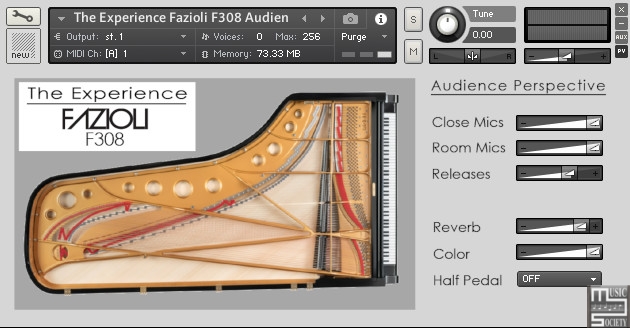
Fazioli’s Crown Jewel with Audience and Player VR perspectives.
I guess I’m old school. When I starting my sampling journey with Pianobook in 2020, I really liked the idea of preserving a piano’s character, telling its story, and sharing its sound. Since then Pianobook has evolved into a comprehensive resource of sonic textures that go well beyond acoustic instruments. While I love all of them, I always return to my bread and butter – the pianos.
So I present The Experience Fazioli F308. The Fazioli F308 is a concert grand that extends more than 10 feet, and is almost twice as long as my personal piano. The length of the bass strings become obvious when you play the lower octaves. Fazioli makes only 140 pianos per year, and the F308 is the crown jewel – the rarest of exceptional instruments.
This particular F308 is owned by a friend of mine and it, of course, has an interesting story. Delivered about 3-4 years ago, it was supposed to have Paolo Fazioli’s signature. But when it arrived, the signature was missing. About a year later, around the same time as the NAMM show in Los Angeles, Paolo Fazioli went to his house, played some Chopin on it and then signed it for him.
Technical Stuff:
* Audience and Player Perspectives using 10 microphones
* Ambisonic VR routing
* 5 Velocity Layers
* Half Pedaling
I’ve updated the Experience series with multiple microphone angles and a new ambisonic/virtual reality workflow. There are two microphone groups:
The first is the Audience Perspective, which are a pair of hand built U87 clones placed over the soundboard and a pair of C214’s placed XY about a meter away. Mix and reverb to taste.
The second is the Player Perspective, with my new ambisonic array of 3 XY pairs. These can be enjoyed in two ways: the first is to simply mix the 3 XY pairs. But the real virtual reality experience can be had if you place the 6 microphone perspectives with ambisonic plugins and control the soundspace using head tracking. I’ll provide a video on how to do this. Note that the player perspective is provided totally dry without any reverb. This is because dry samples are needed before ambisonic processing – reverb changes as you move your head, so you need the dry signal. See video on setup, and also check out this software that can help with the head tracking with your webcam!
https://github.com/blah1898/the-experience-face-tracker
The microphone angles are organized differently depending on platform. For Kontakt, which supports 6 channel output, there is one file for Audience and one file for Player. For SFZ, which don’t support 6 channel output, there are five total files. The first is the standard Audience perspective, which is a mix of the close and room mics. The Player perspective contains four files. The first Player perspective is a mixdown of all 3 mic pairs. The final three files are the separate stereo head angles that can be mixed using the IEM plugin suite, which can help make a VR experience through ambisonics.




